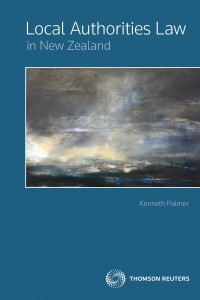Local Authorities Law in NZ <br>- 7 major developments
The publication (due March 2012) of Local Authorities Law in New Zealand, supersedes a former book on the topic by the author published in 1993.
Since that date substantial changes have occurred in legislation applying to local authorities. This brief overview identifies seven major developments in the law and practice.
7 changes in local authorities law and practice
1. Power of general competence
The Local Government Act 2002 introduced a power of general competence to replace the former legal position that all actions of local authorities required specific authorisation or were necessarily incidental to authorised purposes. The ultra vires rule has largely been displaced by the new powers, except in relation to regulatory or fiscal functions. Accordingly, the authorisation of bylaws and rating powers remains subject to the older doctrines.
To give the power of general competence some direction, and to remind Councils of basic functions, a prescription of core services was introduced in 2010. Waste management duties have been updated.
2. Financial management strategies
Commencing in 1996, with abolition of the former Local Authorities Loans Board, local authorities have had greater powers to undertake works and to fund the works through different fiscal policies and determinations. The ability of local authorities to borrow money, or to undertake rating, has been substantially liberalised. The introduction of differential rating, and annual charges, has been modernised, and the ability to impose targeted rates has been extended. Again, to provide direction and restraint, the law requires councils to develop strategies for funding and borrowing, and to provide for implementation through the long-term plan and annual plan, and to make an annual report. These obligations are subject to overview by the Auditor-General.
3. Decision-making procedures
As part of the liberalisation of powers through the general power of competence, and the obligation to provide for funding strategies, the Local Government Act 2002 also provides for a new matrix of decision-making. The more significant decisions such as making of bylaws, approving the long-term plan and annual plan, are subject to the special consultative procedure. That procedure applies to an alteration in the provision of significant infrastructure or disposal of a strategic asset, and establishment of a council-controlled organisation. The special consultative procedure allows for public submissions and hearings, and provides the necessarily layer of local democracy which is part of the principles of local governance. The validity of the consultation procedures has been the subject of several recent decisions of the High Court. The ability to take judicial review procedures in respect of a council decision is an important constitutional safeguard.
4. Rating powers
The Local Government (Rating) Act 2002 updates the liability of properties of the Crown and certain community bodies for rates. The Act provides a complex process for differential rating, annual charges, targeted rates, and determining the mix of rates which may be imposed.
5. Resource Management
The Resource Management Act 1991 imposes on local authorities substantial obligations in respect of regulating land use activities, and enables the levy of financial contributions in respect of developments. The RMA has been significantly amended over the last two decades, increasing expectations for water allocation plans, and zoning plans. Higher standards for air pollution and other matters are prescribed under a raft of new national policy statements and national environmental standards. Utilisation of the marine and coastal area may be subject to obligations to iwi who successfully obtain protected customary rights or a customary title.
6. Auckland Council
The restructuring of the Auckland region in 2009/10, following the Royal Commission report, provides a new level of “provincial” governance. The Auckland Council functions are supplemented by the local boards, a range of council-controlled organisations, and a Maori statutory board. A spatial plan obligation provides scope for visionary local governance and management.
7. Local authority liability
The liability of local authorities in respect of negligence in the administration of building activities, has been confirmed by the Supreme Court in the Byron Avenue and Sunset Terraces litigation (2010). Liability for leaky homes has led to a distinction in respect of commercial properties for which liability is not generally imposed. Recently, the Crown has acknowledged a moral responsibility, and has through legislation accepted a proportionate contribution for claims in certain circumstances.
The developments outlined above, compromise a sample of changes that have occurred since 1993. Information on these changes and many others are set out in the Local Authorities Law in New Zealand book, due for release in March. The book is complemented by the Brookers Local Authorities Law Handbook 2012, which contains reprints of the major enactments in the local government area.
About Ken Palmer:
Ken Palmer is Associate Professor at the Auckland University School of Law. He has particular interest in local government, resource management, environmental, and heritage law as well as public works acquisitions.
Find out more:
To find out more about the book and pre-order click the link below:
Local Authorities Law in New Zealand
